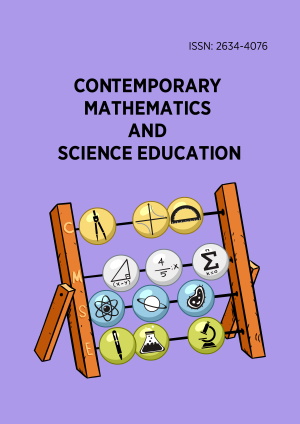Research Article
Students’ Transition from Grade X to CAIE A-Level: In the Context of Mathematics Curriculum in Nepal
More Detail
1 Budhanilkantha School, NEPAL2 Nepal Open University, NEPAL3 Tribhuvan University, NEPAL* Corresponding Author
Contemporary Mathematics and Science Education, 3(2), July 2022, ep22015, https://doi.org/10.30935/conmaths/12228
Submitted: 25 January 2022, Published: 13 July 2022
OPEN ACCESS 1576 Views 1013 Downloads
ABSTRACT
This study examines students’ transition from grade X to CAIE A-level in the context of school mathematics curriculum in Nepal. This study is based on the qualitative study design covering a total of ten participants from two A-level schools in Nepal. Content analysis and phenomenology were used as methodological approaches to the study. The study finds that there exist challenges for the students of Nepal during the transition process in different dimensions. The study concludes that there is a substantial gap in contents and assessment systems between the two mathematics curriculums. The study recommends the bridging of mathematical contents, preparing and implementing transition strategies in schools where students transit from grade X to CAIE A-level.
CITATION (APA)
Poudel, N., Manandhar, R., & Sharma, L. (2022). Students’ Transition from Grade X to CAIE A-Level: In the Context of Mathematics Curriculum in Nepal. Contemporary Mathematics and Science Education, 3(2), ep22015. https://doi.org/10.30935/conmaths/12228
REFERENCES
- Aktas, F. N., Akyıldız, P., & Dede, Y. (2021). A model for developing preservice mathematics teachers’ mathematical language skills in the context of authentic assessment. In T. Barkatsas, & P. McLaughlin (Eds.), Authentic assessment and evaluation approaches and practices in a digital era (pp. 116-141). Brill. https://doi.org/10.1163/9789004501577_006
- Alase, A. (2017). The interpretative phenomenological analysis (IPA): A guide to a good qualitative research approach. International Journal of Education & Literacy Studies, 5(2), 9-19. https://doi.org/10.7575/aiac.ijels.v.5n.2p.9
- Awasthi, R. P., Acharya, N., & Goshain, K. (2072 B.S.). Math class-10. Curriculum Development Center.
- Bridges, W. (2009). Managing transitions: Making the most of change. Da Capo Lifelong Books.
- Cambridge International Examinations. (2018). Syllabus: Cambridge international AS and A level mathematics. Cambridge Assessment International Education. http://www.cambridgeinternational.org/images/164759-2016-syllabus.pdf
- Department of Education. (2014). Transitioning from primary to secondary school. State of Victoria. http://www.education.vic.gov.au/Documents/school/teachers/teachingresources/diversity/Transprmrytosec.pdf
- Evans, D., Borriello, G. A., & Field, A. P. (2018). A review of the academic and psychological impact of the transition to secondary education. Frontiers in Psychology, 9, 1482. https://doi.org/10.3389/fpsyg.2018.01482
- Gueudet, G., Bosch, M., Disessa, A. A., Kwon, O. N., & Verschaffel, L. (2016). Transitions in mathematics education. Springer. https://doi.org/10.1007/978-3-319-31622-2
- Kentucky Department of Education. (2011, 02 12). Identifying the gaps between the Kentucky core academic standards (KCAS) for ELA and a school’s current curriculum. https://education.ky.gov/school/Documents/Id%20the%20Gaps%20between%20KCAS-ELA%20and%20school%20curric.pdf
- Kitchen, H., Bethell, G., Fordham, E., Henderson, K., & Li, R. R. (2019). Using the evaluation system to promote better assessment and learning. OECD Publishing. https://doi.org/10.1787/ecdc6300-en
- Liston, M., & O’Donoghue, J. (2007). The transition from secondary school mathematics to university. British Educational Research Association Annual.
- Looney, J., Laneve, C., & Moscato, M. T. (2019). Italy: A system in transition case studies from two schools. Organisation for Economic Co-operation and Development. http://www.oecd.org/education/ceri/34260408.pdf
- Moser, A., & Korstjens, I. (2018). Series: Practical guidance to qualitative research. Part 3: Sampling, data collection and analysis. The European Journal of General Practice, 24(1), 9. https://doi.org/10.1080/13814788.2017.1375091
- Neal, P. (2016, October 20). Capita SIMS helping school inspire. http://www.capita-sims.co.uk/resources/blog/bridging-gap-between-primary-and-secondary-school
- Peterson, J. (2015). Gap analysis for 2014 curriculum competencies. Educational Perspectives in Health Information Management, 1-8.
- Robertson, D. L. (1997). Transformative learning and transition theory: Toward developing the ability to facilitate insight. Journal on Excellence in College Teaching, 105-125.
- Schlossberg, N. K. (1981, June 1). A model for analyzing human adaptation to transition. The Counseling Psychology, 9(2), 2-18. https://doi.org/10.1177/001100008100900202
- Schlossberg, N. K. (2011). The challenge of change: The transition model and its applications. Journal of Employment Counseling, 48(4), 159-162. https://doi.org/10.1002/J.2161-1920.2011.TB01102.X
- Shrestha, M. M., Tuladhar, B. M., Koirala, S. P., Uppadhyay, H. P., Luitel, B. C., Sharma, L., & Bajracharya, P. M. (2012). National curriculum framework for mathematics. Council for Mathematics Education, Nepal Mathematics SoCAIEty, Nepal Mathematics Centre, Kathmandu.
- Sousa, A. C., Wagner, D. P., Henry, R. C., & Mavis, B. E. (2011). Better data for teachers, better data for learners, better patient care: College-wide assessment at Michigan State University’s College of Human Medicine. Medical Education Online, 16. https://doi.org/10.3402/meo.v16i0.5926
- Stadler, E. (2010). The transition between mathematics studies at secondary and tertiary level individual and social perspective. In Proceedings of the 6th Congress of the European Society for Research in Mathematics Education (pp. 1655-1664).
- Strand, G. M. (2020). Supporting the transition to secondary school: The voices of lower secondary leaders and teachers. Educational Research, 62(2), 129-145. https://doi.org/10.1080/00131881.2020.1750305
- Taverner, S., Baumfield, V., Clark, J., Fisher, P., Hall, I., Lin, M., & Pauline Smith, L. T. (2001). Transition between key stages in schools. University of New Castle. http://eprint.ncl.ac.uk/pub_details2.aspx?pub_id=11983
- UNESCO. (2017, November 16). Education. http://www.unesco.org/new/en/education/themes/strengthening-education-systems/quality-framework/technical-notes/defining-curriculum-content/
- Watson, G. (2016, July 2016). Transition. https://www.tes.com/news/school-news/breaking-views/transition-isnt-just-a-matter-first-term-impact-can-last-years
- Wenden, E. J. (2015). Rising to the challenge: Exploring the transition from primary to secondary education in a Western Australian school [Master’s thesis, Edith Cowan University].

 The articles published in this journal are licensed under the CC-BY Creative Commons Attribution International License.
The articles published in this journal are licensed under the CC-BY Creative Commons Attribution International License.